NE Denver, What Do You Think? Go to our website to submit your votes for Front Porch – Northeast Denver’s first “Best of” dining list.
https://www.surveymonkey.com/r/FPDining2017
“Best of” lists seem to be proliferating these days—and they rank everything from restaurants to yoga classes to best characters from 1970’s sitcoms.
Many are driven by the internet: click-bait for web surfers and lead-generators for advertisers. Some lists offer guidance for consumers: best cars, best schools, best mutual funds. And then there are lists based on the numbers: the hottest real estate markets, the highest median incomes by zip code, the per capita crime rates of cities.
Bob Morse, chief data strategist for U.S. News and World Report, a longstanding, prominent list maker, says, “There definitely is list pollution, and it can make it hard for the consumers of the information to distinguish a good list from a bad list,” especially when there are wide differences on the same topic.
So what gives with all these lists? Here the Front Porch offers our own list—five things readers should keep in mind as they look at lists, with examples from our own part of town.
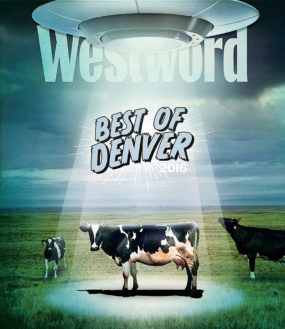
1.) User-Generated Lists: Crowd Sourcing…or Marketing?
Websites like Yelp, TripAdvisor or Rotten Tomatoes are hugely popular for the ratings they provide. These ratings are supposedly generated through users – normal people reviewing the hotels, restaurants, and other businesses they frequent. Many turn to these lists, trusting that fabled “crowd sourcing” will lead them in the right direction.
But these kinds of lists can be hard to evaluate, says Morse. With publicly generated lists, “there’s no way of knowing how it’s done.” Users can potentially vote multiple times and some have axes to grind or businesses to promote, unlike polls that are ranked solely on experts’ opinions. There can be value to “wiki lists,” but consumers should recognize the hazards of trusting them. The chart below is an example of a user-generated list.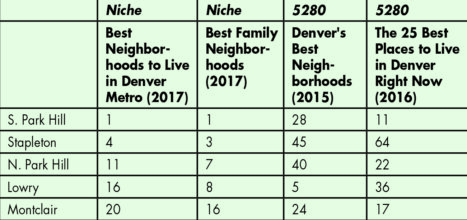
Current Yelp Rankings of the Top 10 Restaurants in Park Hill and Stapleton (sorted by “Highest Rated” on Yelp)
5280 Magazine produces many local lists, including its famous “Top Doctors” expert-driven list. 5280’s “Top of the Town” includes nearly 100 subcategories of dining, culture, shopping, and services, both editorially selected and recommended by readers. For the latter, readers submit their favorites via online ballots.
“We absolutely do think there’s validity to that [readers’ choices],” says Lindsay Koehler, deputy editor at 5280. “Often the readers’ choice or crowd-sourcing ends up highlighting some of the iconic or classic businesses,” versus the newer businesses that editors often favor. She adds that 5280 monitors reader submissions, checking URLs to make sure thousands of votes aren’t coming from one computer. “On the whole,” Koehler says, “we try to trust people as much as we can,” but she acknowledges It can be hard to tell if marketing efforts by businesses are driving the ballot results.
Local Favorites Selected in 5280’s 2016 “Top of the Town” Survey
Another problem with consumer-generated lists is that, well, readers’ tastes might not really be all that illuminating. Westword has been publishing “Best of Denver” lists, both editorial and “Readers’ Choice” varieties, since the early 1980’s. “The year something other than McDonald’s won in Readers’ Choice for best french fry we were so excited,” says Westword Editor Patricia Calhoun.
Westword Readers’ Favorite Restaurants in NE Denver
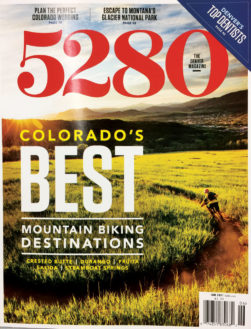
2.) Are Editorial or Expert Picks Better?
Editors’ choice lists, like best restaurants or yoga studios, depend on the tastes of experts. “We consider ourselves tastemakers,” says Koehler of 5280. But what does that say about NE Denver restaurants? None made the cut in 5280’s “Top of the Town” editors’ choice list in 2016, although Park Hill’s Bistro Barbès squeaked into 5280’s “Denver’s 25 Best Restaurants 2016” at #25. With some recent editorial chatter in the magazine about the new Stanley and Eastbridge restaurants, perhaps that will change in 2017.
“We have educated opinions,” says Calhoun of Westword. “We want to share with people what we think is the best.” And she believes the editors’ opinions make for a stronger list. Calhoun says around 20 people on her staff work year-round on the “Best of Denver” lists, selecting favorites in 400-600 categories of food, drink, culture, shopping, and sports, eating hundreds of burgers to make their expert picks.
Experts’ Picks in Westword’s “Best of Denver” Food and Drink 2017
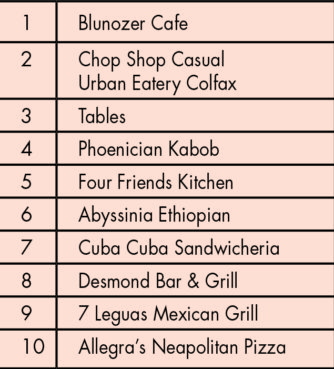
Current Yelp Rankings of the Top 10 Restaurants in Park Hill and Stapleton
(sorted by “Highest Rated” on Yelp)
Sometimes readers question the relationship between entities featured on the lists and the publication that selected them, however. “It is the most heart-wrenching accusation you get after you’ve spent months working on the “Best of Denver,” says Calhoun. While she acknowledges that there are allegations, Calhoun asserted, “We certainly would never in a million years consider taking money to put someone on a list,” a sentiment echoed by Koehler at 5280.
3.) Aren’t Objective Lists the Best?
Even objective lists need to be approached with caution. A list that ranks cities by crimes per square mile – crime density that is – might rank a large city with lots of high rises as more dangerous than a sprawling one, even if the per capita crime incidence is the same.
But even per capita crime rates must be examined. In a neighborhood with a lot of commercial activity—say, a really big Wal-Mart for example—property crime in general might look high due to shoplifting activity at businesses, even though the residential crime rate is low.
For example, the highest-ranking Northeast Denver neighborhood in the Front Porch’s distribution area for per capita property crime was Stapleton. Last year, it ranked 11th out of 78 neighborhoods in the city, and this year, so far, it’s at 14th. Sounds bad, right? Time to start hiring patrols, installing cameras, petitioning the city for more officers?
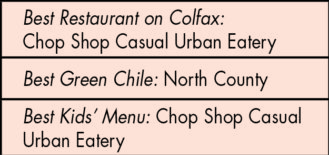
Experts’ Picks in Westword’s “Best
of Denver” Food and Drink 2017
But check out the residential burglaries ranking, a subcategory that is probably most worrisome to neighborhood residents. It’s not so bad at 37. And in the category that matters most of all, overall violent crime, Stapleton is ranked 44th of 78, well under the median.
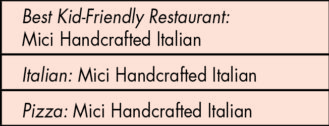
Local Favorites Selected in 5280’s
2016 “Top of the Town” Survey
Year-to-Date Crime Rankings as of June 8
And if you really want to geek out, go to the city’s Denver Crime Map website* and start playing around with the categories. Taking “larceny” out of Stapleton property crimes eliminates the myriad shoplifting incidents that occur at Wal-Mart and the Northfield Stapleton mall. Select only for “violent crimes” and it looks like the majority occur at the Northfield mall—perhaps the product of late night drinking gone awry. In other words, even so-called objective lists can present a misleading view of their subjects unless you’re willing to dig deeper.

Westword Readers’ Favorite Restaurants in NE Denver
4.) Do Fancy Formulas Lead to Better Results?
Some lists take data and apply algorithms to arrive at supposedly serious results, but these might not match with reality.
“The outcome of a list depends on its methodology,” says Morse of U.S. News. “To have a good list means…the consumers of the list can readily understand it and it makes sense to them” he continued. “It has some meaning in relation to currently perceived standards.” As an example, Morse says readers of U.S. News would question its “Best Colleges” list if C.U. Boulder were to be ranked the number one public university in the country. “It wouldn’t have a lot of credibility.” (Of course, locals know that CU, currently ranked by U.S. News as #38 among public universities, has some pretty impressive programs.)
Neil Westergaard, editor of the Denver Business Journal, says their editors scrutinize the outside lists they consider for publication. “We look at the methodology these sources use to do the rankings, and sometimes we toss them because we’re not comfortable in how they did the ranking,” he says.
A popular type of methodological list is the kind that ranks the best cities, zip codes or neighborhoods. When Denver reached #1 ranking in the 2015 U.S. News “Best Places to Live in the USA” list and then fell last year to the #2 spot, bloggers and realtors across the metro area were atwitter.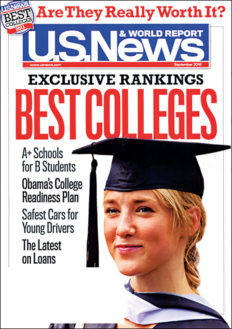
Local publications and internet sites seek to replicate that buzz with lists of Denver neighborhoods—which are best for millennials, which are best for families, which are best in general? It may come as no surprise that none of the Northeast Denver neighborhoods where the Front Porch is delivered placed as millennial or hipster favorites. But it is surprising how widely rankings can vary, as shown below in the rankings of NE Denver neighborhoods.
NE Denver Neighborhood Rankings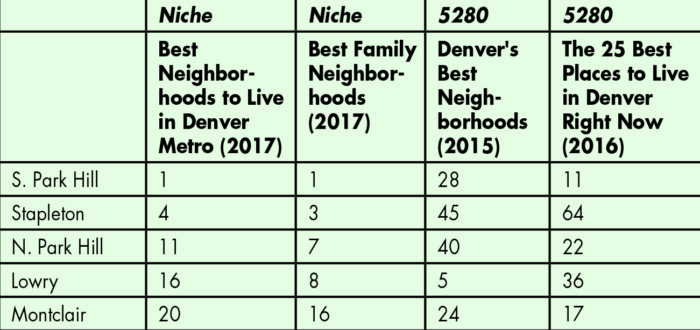
Niche is a website that analyzes public data and reviews to produce comprehensive rankings of schools, colleges, and neighborhoods in the U.S. The Niche lists, which were published in the Denver Business Journal, looked at 14 different categories, each contributing from 5 – 15% of the total score. Their most heavily weighted measure, at 15%, is “percentage of residents who have received a bachelor’s degree or higher” followed by measures of cost of living, housing, and public schools, each weighted 10%. It is a much more complicated formula than 5280’s and uses totally different criteria, and thus yields completely different results.
Looking at a chart like this, one can’t help but wonder how does Park Hill rate #1 on the Niche lists but 28th and 11th in 5280? How in the world is Stapleton considered 64th (out of 78) neighborhoods in Denver as a best place to live by 5280?
It comes down to methodology. The lists by 5280 included four measures: year-over-year real estate appreciation (35%), per capita total crime (30%) school ratings based on School Performance Framework (SPF) scores (15%), and an “X factor score” (20%), which “accounts for things that can’t easily be quantified, such as access to open space, nearby public transportation, and restaurant and nightlife options.”
“No matter what direction you decide to go or what data points you use, somebody’s going to disagree with it,” says 5280’s Koehler. But that is part of what makes such lists so appealing – that they engage readers in agreement or disagreement.
How Easy Is it To Ditch the Car in Your Neighborhood?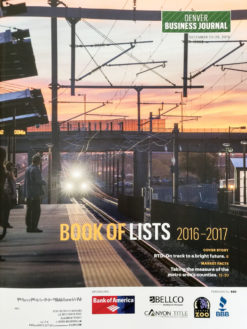
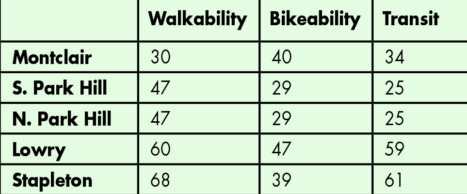
5.) Are Lists “Junk Food” or Healthy Fast Casual?
Unlike long-form articles, “best of” lists can’t delve deeply into their subjects—they are a convenient, shorthand way to get information. When looking at subjects that are complex, like schools, cities, professionals, they don’t capture the whole story. Their aim is to appeal to readers by providing interesting information packaged for easy consumption. Is their value purely entertainment and reader engagement, or do they provide something more nutritious to the intellect?
“Not every story is a comprehensive examination, a cover story, or an eight-part series,” says Westergaard. “For what it is, the relevant information is there.” For a busy reader, being able to quickly capture the relevant data points through a list is helpful and illuminating. “Lists can be a way to illustrate an important issue like crime. People really want to know what neighborhoods have the most kinds of crime,” says Calhoun. “With data, you can do a deeper dive into presenting a story that way. In a list format, it’s just easier to digest than if you write it as a straight narrative.”
–––––––––
But perhaps the bottom line is the bottom line when it comes to “best of” lists. They readily engage readers, who then click websites and buy magazines. “We’ve learned over the years that…the issues that have top dentists, top doctors, or top 25 restaurants are solid newsstand sellers,” says Koehler.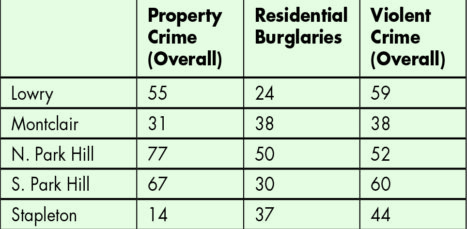
“Readers love to compare themselves to other cities, regions and companies,” says Westergaard. “So when we rank ‘Best Cities for Retirement’ or ‘Best Cities for Business Start-ups,’ those generate pretty monster traffic, especially when we’re at the bottom or the top of the list.”




0 Comments